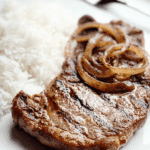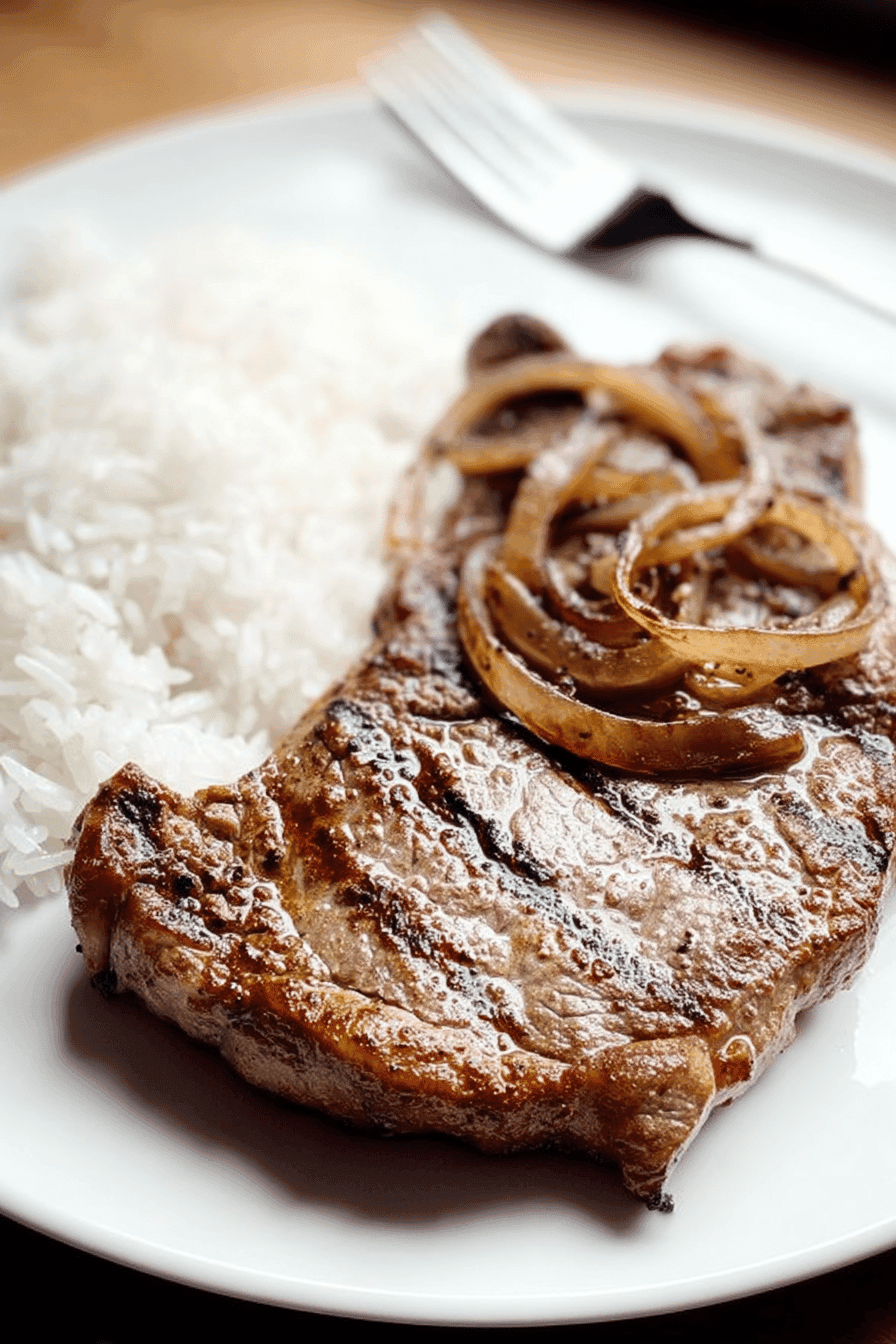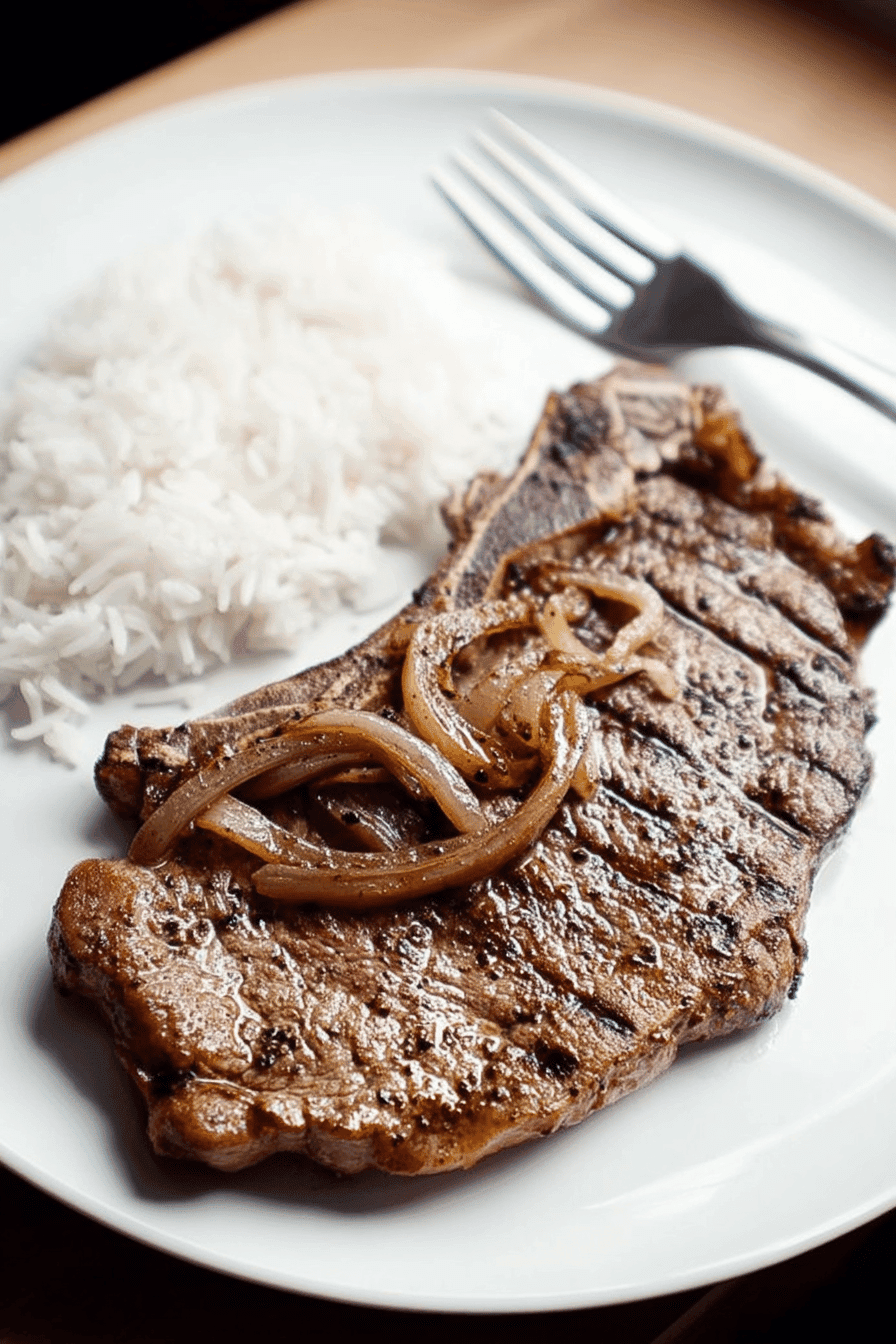Benefits and Advantages of palomilla steak
Palomilla steak stands out for its quick and simple preparation, making it ideal for home cooks of all levels. This dish uses minimal ingredients and straightforward techniques, allowing it to be made swiftly without sacrificing robust flavor. It offers a high protein content vital for muscle repair and sustained energy, appealing to health-conscious individuals. The marinade’s fresh citrus and garlic not only infuse bright, vibrant flavors but also provide antioxidants that may support overall wellbeing. Palomilla steak’s versatility in cooking whether grilled or pan-seared caters to various dietary needs and preferences. Its lean cuts like top sirloin or top round when tenderized ensure tenderness and quick cooking, making it a favorite for those wanting a nutritious, satisfying meal that honors authentic Cuban culinary traditions.
Jump To
- 1. Benefits and Advantages of palomilla steak
- 2. Essential Ingredients for palomilla steak
- 3. Dietary Substitutions to Customize Your palomilla steak
- 4. How to Prepare the Perfect palomilla steak: Step-by-Step Guide
- 5. Advanced Tips and Variations
- 6. How to Store palomilla steak: Best Practices
- 7. Nutritional Value of palomilla steak
- 8. FAQs: Frequently Asked Questions About palomilla steak
- 9. palomilla steak
Essential Ingredients for palomilla steak
- 1 pound thinly sliced beef skirt steak or top sirloin/top round (butterflied and tenderized to about 1/4 inch thickness)
- 10 cloves garlic, smashed
- 1/3 cup mojo marinade (homemade or store-bought)
- 1/4 cup lime juice or sour orange juice (or a mix of orange and lime juice)
- 2 teaspoons complete seasoning or sazón blend (including onion powder, garlic powder, cumin, oregano, paprika, salt, pepper)
- 1 teaspoon garlic powder (optional)
- Salt to taste
- 1/4 cup olive oil or avocado oil (to coat and tenderize)
- 2 to 3 tablespoons neutral oil (vegetable, canola, or avocado oil) for frying
- 1 medium to 4 medium onions, thinly sliced (for topping)
- Fresh parsley or cilantro for garnish (optional)
- Lime wedges for serving (optional)
For those seeking plant-based options, portobello mushrooms or seitan can replace beef, while gluten-free tamari or soy sauce adds umami without gluten.
Dietary Substitutions to Customize Your palomilla steak
Palomilla steak is adaptable to various dietary requirements and preferences through these substitutions:
- Plant-Based Proteins: Substitute beef with grilled portobello mushrooms or marinated seitan to create vegan-friendly versions while maintaining texture and flavor.
- Gluten-Free Options: Use gluten-free soy sauce or tamari in the marinade to exclude gluten without losing savory depth.
- Lean Cuts for Low-Calorie Diets: Replace skirt steak with lean cuts like eye of round or sirloin to reduce fat content.
- Seasoning Adjustments: Use low-sodium seasoning blends and limit added salt to reduce sodium intake, suitable for blood pressure management.
- Garlic Alternatives: When fresh garlic is unavailable, substitute with garlic powder or roasted garlic paste to maintain flavor integrity.
- Oil Choices: Swap olive or avocado oil for lighter vegetable oils to reduce calories or accommodate dietary fat preferences.
These options keep the core flavors while enhancing accessibility and dietary fit.
How to Prepare the Perfect palomilla steak: Step-by-Step Guide
- Season the Steak: Coat the thinly sliced beef skirt steak with salt, black pepper, minced garlic, cumin, fresh lime or sour orange juice, and mojo marinade. This mixture tenderizes and flavors the meat deeply. For vegan alternatives, marinate portobello mushrooms or seitan identically.
- Marinate: Place the steak in a shallow dish with thinly sliced onions layered on top or mixed in. Marinate for at least 20 minutes; ideally 1 to 3 hours or overnight for optimum flavor absorption and tenderness.
- Prepare the Pan or Grill: Heat 2 to 3 tablespoons of neutral oil (vegetable, canola, or avocado) in a large 10-inch nonstick skillet, cast iron pan, or grill over medium-high heat.
- Sear the Steak: Remove the steaks from the marinade, shaking off excess. Work in batches to avoid overcrowding, and sear each steak for 1 to 3 minutes per side until a golden-brown crust forms and the desired doneness is reached. Vegetarian substitutes usually require less cooking time avoid overcooking.
- Cook the Onions: After cooking the steaks, reduce the heat to medium-low. In the same pan, sauté the thinly sliced onions for 2 to 10 minutes until softened and caramelized, deglazing with a splash of water if necessary to lift flavorful bits from the pan.
- Rest and Slice: Let the cooked steak rest for 5 minutes to distribute juices evenly, then slice thinly against the grain for tenderness. Slice plant-based alternatives according to texture.
- Serve: Plate the palomilla steak topped with caramelized onions, garnish with fresh parsley or cilantro and lime wedges if desired. Pair with traditional Cuban sides such as white rice, black beans, maduros, or yuca to complete the meal.
Following these steps ensures a tender, flavorful palomilla steak experience at home. For inspiration, consider serving it alongside dishes like Garlic Chicken or Hamburger Steaks with Onion Gravy.
Expand your culinary knowledge with expert guides like How to Cook Palomilla Steak, and enhance marinades with tips at Tips for Making the Best Mojo Marinade.
Advanced Tips and Variations
- Marinate Longer for Enhanced Flavor: While 20 minutes is sufficient, marinating the palomilla steak overnight in the refrigerator allows the citrus-garlic mojo to fully penetrate, tenderizing and deepening the taste.
- Use a Dry Rub for Extra Depth: Combine smoked paprika, oregano, and cumin with traditional seasonings for a smoky twist on the classic palomilla flavor.
- Try Different Citrus Juices: Experiment with sour orange juice if available, or a mix of fresh lime and orange juice to add brightness and authenticity.
- Cook with High Heat: Use a wide, heavy skillet (cast iron or stainless steel) on medium-high heat to get a perfect sear without steaming the meat. Avoid overcrowding the pan to maintain heat balance.
- Caramelize Onions to Perfection: After cooking the steak, reduce heat to medium-low and sauté onions slowly to develop natural sweetness, using a splash of water to deglaze pan fond as needed.
- Experiment with Garnishes: Fresh parsley, cilantro, or a squeeze of lime juice on the finished dish complements the flavors. Optionally, serve with avocado slices or a side of yuca for added texture.
- Vegan Twist: Use grilled portobello mushrooms or marinated seitan with the mojo marinade for a plant-based alternative that captures the essence of palomilla steak.
Applying these tips and variations guarantees a flavorful, tender palomilla steak tailored to your taste preferences and dietary needs.
How to Store palomilla steak: Best Practices
Proper storage is key to maintaining the delicious taste and texture of palomilla steak:
- Refrigerate Promptly: Store leftovers within two hours after cooking in an airtight container to prevent spoilage.
- Consume Within Three Days: Refrigerated palomilla steak remains safe and tasty for up to 3 days when properly sealed.
- Freezing for Longer Storage: Wrap the steak tightly in plastic wrap and aluminum foil or use a vacuum-sealed bag before freezing. For best flavor and texture, consume within 2 months.
- Reheating Recommendations: Avoid microwaving to prevent toughening; gently reheat in a skillet over low heat or in an oven at 300°F (150°C) until warmed through, adding a splash of water to preserve moisture.
- Storing Vegan Alternatives: Follow similar refrigeration and freezing practices to retain freshness and texture.
Following these guidelines helps you keep palomilla steak fresh, safe, and delicious even after storage.
Nutritional Value of palomilla steak
| Nutrient | Amount per Serving | Health Benefits |
|---|---|---|
| Calories | 300-350 kcal | Provides energy with moderate caloric content |
| Protein | Approximately 53 g | Supports muscle repair and growth |
| Fat | 11 g | Contains healthy fats aiding nutrient absorption |
| Carbohydrates | 7 g | Low carb content, suitable for low-carb diets |
| Iron | High | Essential for oxygen transport and energy metabolism |
| Potassium | High | Supports heart and muscle function |
FAQs: Frequently Asked Questions About palomilla steak
What cut of meat is used for palomilla steak?
Palomilla steak is typically made from thinly sliced top sirloin or top round beef. These cuts are lean and tender, especially after pounding them thin. The steak is often butterflied and tenderized with a meat mallet to about 1/4 inch thickness, which helps it cook quickly and absorb marinades well.
How long should I marinate palomilla steak for best flavor?
For optimal flavor, marinate palomilla steak for at least 30 minutes up to 3 hours at room temperature. If time permits, marinating it overnight in the refrigerator can deepen the taste. Avoid marinating longer than 24 hours to prevent the meat from becoming mushy due to the acidic ingredients in the marinade.
What is the traditional method for cooking palomilla steak?
Traditionally, palomilla steak is cooked by pan-frying or shallow-frying in a generous amount of hot oil for 1 to 2 minutes per side until browned. This quick cooking preserves the tenderness and flavor. The steaks are then served with sautéed onions that are cooked until soft and lightly caramelized.
Can I prepare palomilla steak ahead of time?
Yes, you can marinate the steak up to 24 hours before cooking, which can help intensify the flavors. However, it’s best to cook and serve the steak fresh since palomilla tastes best immediately after frying to avoid toughness from sitting too long.
What side dishes are traditionally served with palomilla steak?
Palomilla steak is commonly accompanied by white rice, black beans, and maduros (sweet fried plantains). Other popular sides include fried potatoes or fresh salads for a lighter option. These sides complement the savory flavors and balance the meal.

palomilla steak
- Total Time: 20 minutes to 3 hours 20 minutes
- Yield: 4 servings
- Diet: Gluten-Free
Description
🥩 Palomilla steak is a lean, tender Cuban classic rich in protein and quick to prepare, making it perfect for a satisfying weeknight meal.
🧄 The citrus-garlic mojo marinade infuses vibrant flavors while the caramelized onions add a sweet, savory finish that elevates the dish.
Ingredients
– 1 pound thinly sliced beef skirt steak or top sirloin/top round (butterflied and tenderized to about 1/4 inch thickness)
– 10 cloves garlic, smashed
– 1/3 cup mojo marinade (homemade or store-bought)
– 1/4 cup lime juice or sour orange juice (or a mix of orange and lime juice)
– 2 teaspoons complete seasoning or sazón blend (including onion powder, garlic powder, cumin, oregano, paprika, salt, pepper)
– 1 teaspoon garlic powder (optional)
– Salt to taste
– 1/4 cup olive oil or avocado oil (to coat and tenderize)
– 2 to 3 tablespoons neutral oil (vegetable, canola, or avocado oil) for frying
– 1 medium to 4 medium onions, thinly sliced (for topping)
– Fresh parsley or cilantro for garnish (optional)
– Lime wedges for serving (optional)
Instructions
Season the Steak: Coat the thinly sliced beef skirt steak with salt, black pepper, minced garlic, cumin, fresh lime or sour orange juice, and mojo marinade. This mixture tenderizes and flavors the meat deeply. For vegan alternatives, marinate portobello mushrooms or seitan identically.
Marinate: Place the steak in a shallow dish with thinly sliced onions layered on top or mixed in. Marinate for at least 20 minutes; ideally 1 to 3 hours or overnight for optimum flavor absorption and tenderness.
Prepare the Pan or Grill: Heat 2 to 3 tablespoons of neutral oil (vegetable, canola, or avocado) in a large 10-inch nonstick skillet, cast iron pan, or grill over medium-high heat.
Sear the Steak: Remove the steaks from the marinade, shaking off excess. Work in batches to avoid overcrowding, and sear each steak for 1 to 3 minutes per side until a golden-brown crust forms and the desired doneness is reached. Vegetarian substitutes usually require less cooking time avoid overcooking.
Cook the Onions: After cooking the steaks, reduce the heat to medium-low. In the same pan, sauté the thinly sliced onions for 2 to 10 minutes until softened and caramelized, deglazing with a splash of water if necessary to lift flavorful bits from the pan.
Rest and Slice: Let the cooked steak rest for 5 minutes to distribute juices evenly, then slice thinly against the grain for tenderness. Slice plant-based alternatives according to texture.
Serve: Plate the palomilla steak topped with caramelized onions, garnish with fresh parsley or cilantro and lime wedges if desired. Pair with traditional Cuban sides such as white rice, black beans, maduros, or yuca to complete the meal.
Notes
🔪 Ensure steaks are thinly sliced or pounded about 1/4-inch for quick, even cooking.
⏲️ Marinate for 20 minutes up to 3 hours at room temperature to achieve tender flavor without degrading texture.
🍳 Avoid overcrowding the pan when searing to maintain a good crust and prevent steaming.
- Prep Time: 10 minutes
- Marinating time: 20 minutes to 3 hours
- Cook Time: 10 minutes
- Category: Main Dish
- Method: Searing and sautéing
- Cuisine: Cuban
Nutrition
- Serving Size: 1 steak with onions
- Calories: 325 kcal
- Sugar: 2 g
- Sodium: 480 mg
- Fat: 11 g
- Saturated Fat: 2 g
- Unsaturated Fat: 8 g
- Trans Fat: 0 g
- Carbohydrates: 7 g
- Fiber: 1 g
- Protein: 53 g
- Cholesterol: 90 mg
Keywords: palomilla, steak, Cuban, onions



This palomilla steak reminded me of my grandma’s cooking in Havana! 🌴 I marinated the steak overnight, and it turned out amazingly tender. Do you think adding a bit of cumin would enhance the flavor, or would it overpower the lime and garlic?
★★★★★